

STM32F4 uses SPI for the MAX6966 LED driver. The STM32F4xx devices are not short of pins and they can be more flexibly used than on the STM32F1xx types.
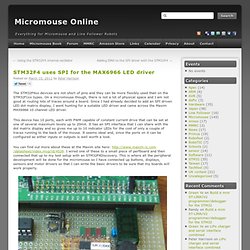
On a micromouse though, there is not a lot of physical space and I am not good at routing lots of traces around a board. Since I had already decided to add an SPI driven LED dot matrix display, I went hunting for a suitable LED driver and came across the Maxim MAX6966 10 channel LED driver. This device has 10 ports, each with PWM capable of constant current drive that can be set at one of several maximum levels up to 20mA. It has an SPI interface that I can share with the dot matrix display and so gives me up to 10 indicator LEDs for the cost of only a couple of traces running to the back of the mouse.
It seems ideal and, since the ports on it can be configured as either inputs or outputs is well worth a look. Although the ports on the MAX6966 can be used as inputs, I decided to use them for output only so relieving me of the need to add an MISO line to the SPI port connection. STM32F4 Discovery ARM Cortex M-4 dev board. I just found this nice little board at Watterott.
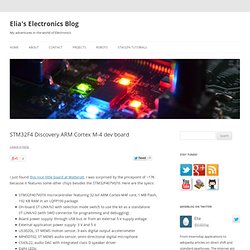
I was surprised by the pricepoint of ~17€ because it features some other chips besides the STM32F407VGT6. Here are the specs: 3spds. View topic - Unexpected I2C behaviour - STM32F4 Discovery. As E-B Felix suggested corretly, the master wasn't in Open Drain mode.
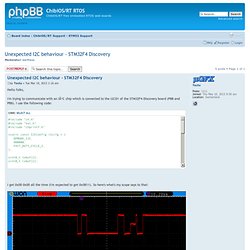
The following two lines fixed this issue: Code: Select all palSetPadMode(GPIOB, 8, PAL_MODE_ALTERNATE(4) | PAL_STM32_OTYPE_OPENDRAIN); /* SCL */palSetPadMode(GPIOB, 9, PAL_MODE_ALTERNATE(4) | PAL_STM32_OTYPE_OPENDRAIN); /* SDA */ However, The result didn't change much. I now got some very triangular waveform which didn't even go up to 3.3V completely. Silicon Valley Redneck: Oooh! Shiny! So I mentioned G codes and/or ReplicatorG a couple of times lately, which might have constituted a Hint.
I'd been pondering 3D printers, of the FDM persuasion, for at least two years now. Early this year, I'd come to the conclusion that there was a legitimate business case to be made for having one, and the now-discontinued Makerbot Replicator, dual extruder variant, was probably about right, and its $1200 Chinese knockoff, the FlashForge Creator, was probably the thing to get, especially given the reviews it was getting on Amazon. Come Monday, finding the business case still there and my finances not totally depleted by taxes and car repairs, I decided it was time to buy... though, in the meantime, FlashForge had come out with a new model, the Creator X, which is basically the same thing in a metal-frame enclosure with plastic panels, instead of plywood.
The price on the original Creator had dropped a little, while the Creator X was at $1300... only, on Monday, it was $1156. Anyway... Emudev: STM32F4 Discovery Hello World (with blinking lights!) What better way to start off a new blog than with a hello world!?
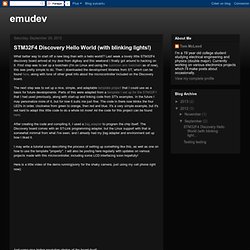
Last week a lovely little STM32F4 discovery board arrived at my door from digikey and this weekend I finally got around to hacking on it. First step was to set up a toolchain (I'm on Linux and using the summon arm toolchain as of now), this was pretty simple to do. Then I downloaded the development libraries from ST, which can be found here, along with tons of other great info about the microcontroller included on the Discovery board. The next step was to set up a nice, simple, and adaptable template project that I could use as a basis for future developments.
STM32F4 Discovery VGA (No SPI, No DMA) Open source OSX IDE/toolchain for the STM32F4 Discovery. Alexwhittmore has posted a detailed tutorial highlighting an open source IDE and toolchain for the STM32F4 dev board on Max OSX Lion.
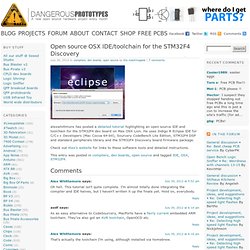
He uses Indigo R Eclipse IDE for C/C++ Developers (Mac Cocoa 64-bit), Sourcery CodeBench Lite Edition, STM32F4 DSP and standard peripherals library and the STM32F4 Discovery board firmware package. Check out Alex’s website for links to these software tools and detailed instructions. STM32F4 Discovery Review. Created on: 24 August 2012 The STM32F4-Discovery evaluation board from ST Microelectronics is a low cost board for evaluating the STM32F4 range of 32-bit ARM Cortex-M4 microcontrollers.
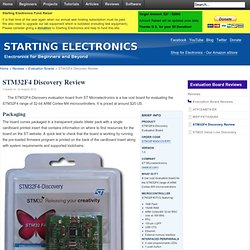
It is priced at around $20 US. Brief Info Product. STM32F4 Virtual COM Port uVision project - easy way to your own VCPMEMSMe. Bus Blaster: Programming the STM32F4 DISCOVERY. Starting with the STM32F4 discovery kit, flashing STM32F37x with stlink. HOWTO direct stdio to DMA-based USART, using dynamic memory allocation, I2C, etc. on the STM32F4 discovery If you need more speed than 8-bit MCUs like Atmel AVR can deliver, yet a device running Linux operating system like Raspberry Pi would be an overkill, the STM32F4 and STM32F37 series 32-bit MCUs might be an option.
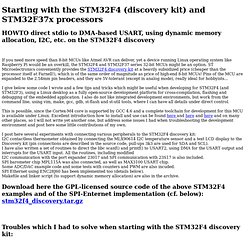
ST Microelectronics conveniently provides the STM32F4 discovery kit at a heavily subsidized price (cheaper than the processor itself at Farnell!) , which is of the same order of magnitude as price of high-end 8-bit MCUs! Pins of the MCU are expanded to the 2.54mm pin headers, and they are 5V-tolerant (except in analog mode), really ideal for hobbyists... I give below some code I wrote and a few tips and tricks which might be useful when developing for STM32F4 (and STM32F3), using a Linux desktop as a fully open-source development platform for cross-compilation, flashing and debugging of the embedded application. 1. 2. 3. 4. 5. 6. CategorySTM32F4 Doscovery.
ShareTo expand the reach of its STM32 mcu family ST microelectronics have come up with an extensible and affordable prototyping platform called STM32 Nucleo series.

Right now STM32 Nucleo are available in 4 different variety featuring F4, F3, F0 and L1 series of STM32 mcu’s. The new STM32 Nucleo boards are mbed-enabled, and support Arduino connectivity [...] A Breakout Board for the STM32F4-Discovery. This is the first in a series of articles about the STM32 family of ARM Cortex microcontrollers.

In this article I will show the breakout board I built for the STM32F4 Discovery module. It features two male DIL headers to easily attach jumper wires and two RS232 serial ports It uses a BusBoard-3U prototyping board to connect the DIL male headers to the Discovery module. STM32F4 Discovery Board Examples on Linux and Mac OS X. Stlink has been updated to include 2 new examples for the STM32F4 Discovery board by jnosky. Here is a quick rundown for trying them out: discovery_demo via GDB: Basically this is the original code that comes on the board. You get the blinking lights, and if you plug in the micro-usb you can use the board as a tilt mouse. If you built your tools with summon-arm-toolchain like I did for my previous post for Mac OS X or my previous post for Linux you will need to update your path. Now to compile the Standard Periph Drivers: Then compile the demo: Now in another terminal start the gdb-server: Then, back to the first terminal and attach:
A Pinout Spreadsheet for the STM32F4-Discovery. STM32F4 + FreeRTOS + TRUEStudio = Awesome-O » Powerhouse Electronics. STM32F4 Discovery ST Micro really gave the world a nice Holiday present this year by releasing the STM32F4 Discovery board! You can get yours at Mouser for $16.25. An amazing dev. board for $16.25. Cybernetics - STM32F4 Discovery Evaluation Board, 32 Bit ARM Cortex M4 168MHz. Introduction: Programming STM32 ARMs under Linux: A Tutorial from Scratch. You've got a (64 bit) Linux box running Debian (or similar e.g. Ubuntu) and want to get started with software development for the bare metal STM32 ARM microcontrollers from ST? Welcome. You want to use the Cortex-M4 devices from the STM32F4 series with floating point (FPU)? Even better! Here's how to do it. Introduction STM32, STM32F2, STM32F4 The STM32 family of microcontrollers from ST is an attractive family of ARM-based 32 bit microcontrollers due to the following reasons:
Void - STM32F4-Discovery board review. Basically the micro controller is similar to 8 bit micro controllers like AVRs, but it is much faster and has more of everything those 8 bit controllers come with: More RAM, more GPIOs, more timers, ... Of course that also means that such a micro controller is more complex than the usual 8 bit controller. The STM32F4 is available in different packages (LQFP, BGA), but none of them are really hobbyist-friendly, which is simply due to the large amount of I/O pins. If it was available in DIL package, it had to be huge. Anyone remember those huge 64 pin DIL 68000 processors?
;) Fortunately, when using the STM32F4 on a board like the STM32F4-Discovery, one does not have to bother about the controller's package. Driving 8-Bit Parallel DAC Using STM32F4-Discovery GPIO. #include "stm32f4xx.h" #define PIN_WR GPIO_Pin_8. Emudev. Getting started with the STM32F4-Discovery board and ChibiOS/RT [ChibiOS/RT free embedded RTOS] Board features This board is impressive when compared to the cost. STM32F407VGT6 Hi-Performance & DSP 32bits MCU, 168MHz Cortex-M4 CPU, 1MB flash, 192KB RAM, 4KB backup RAM. 16 advanced DMA channels, 6 USART, 3 SPI, 3 I2C, 3 ADC, 2 DAC, RTC, CRC unit, Ethernet, 2 USB OTG, lots of timers, two independent watchdogs. [STM32F407]Input Capture (test1) [STM32F407]USART (test1) Doodling With Electrons. Arduino UNO rev3 The Arduino project has been a huge success.
I partly attribute this to Right Place, Right Time, though to say they have benefited from the new Maker's movement is true but ignores how influential it has been on that movement. It is also a tribute to their holistic approach, spending as much if not more time developing the IDE and documentation to go with it- you can be uploading a new program (or "sketch" as they call them) within 5 minutes of getting it out of the box.
I have two Duemilanoves, one Uno R3, and one Diecimila with a busted FTDI chip (meaning not only can it not communicate over USB, but it can't be powered that way either). [Test] STM32 Discovery. Salut à tous ! C’est samedi ! Just a random collection of notes. I & STM32F4-discovery part0. KPY3EP.de.tl - STM32F4 Discovery mit Ethernet. STM32F4 Discovery – Teil 1: Setup unter Debian Wheezy. Für Projekte mit Mikrocontroller habe ich in der Vergangenheit auf Atmels ATmega bzw. ATtiny gesetzt. Das Programmieren mit (AVR)gcc geht unter Debian sehr einfach, da die Pakete im Standard-Repository vorhanden sind. STM32F4 Discovery Board running .NET MicroFramework. Electronics Design Club. Spotlight on: STM32F4-Discovery.
Commentaires sur la vidéo "USB serial test on STM32F4" – Page 1. Stm32. Four STM32-Discovery BaseBoards. DIY – 12V 7.2Ah SMF Battery Charger Circuit. STM32F4xx. STM32L-Discovery board and ChibiOS/RT. Verilog CPLD/FPGA programming from the Linux command line. STM32F4DISCOVERY – great board for starting learn to STM32F4 high-performance MCU. TKJ Electronics » Review: STM32F4-DISCOVERY. Dccharacter's electronics projects (EN) STM32 Discovery-F3 and Discovery-F4 Differences. Searching For A Bit. ZiBlog.RU. The Complete Open DIY Solution for All Your Performance Needs. M32. STM32F4DISCOVERY by STMicro. Commentaires sur la vidéo "Stm32f4 Discovery Kit 320x240 TFT Lcd Türkiye" – Page 1. Embedded Projects. » STM32F4 Discovery and printf() redirection to debug viewer in Keil MDK-ARM Microcontroladores ARM Cortex-M.